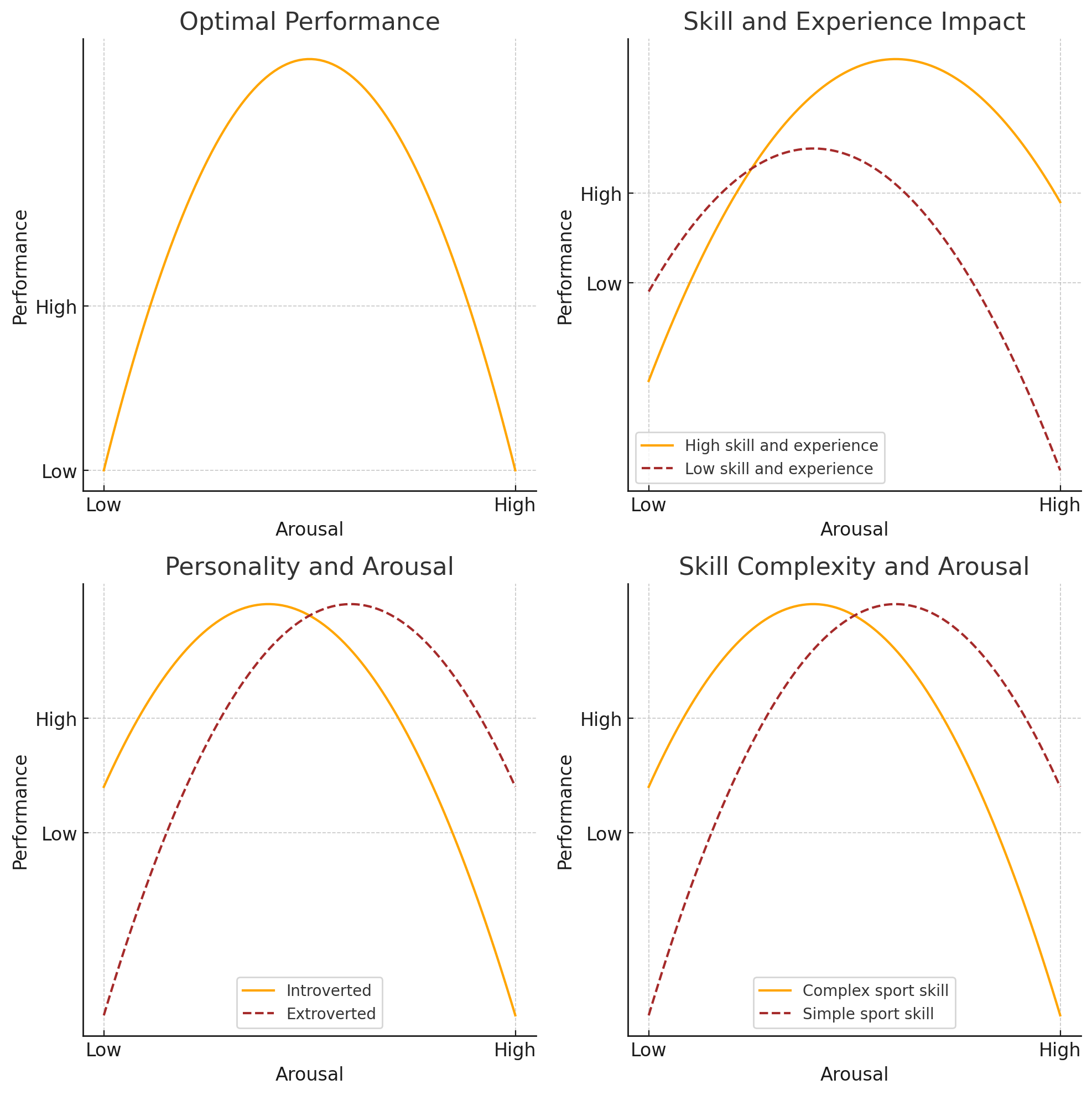Drive theory suggests that as an individual’s arousal or state anxiety increases, performance also increases. This theory follows a linear progression, meaning that highly aroused athletes are expected to perform better. However, this assumption does not always hold true, as excessive arousal can impair performance due to overexcitement or loss of motor control. A key aspect of drive theory is the dominant response concept: arousal can enhance performance of simple or well-learned tasks, but may hinder performance of complex or novel skills when arousal levels are too high. For exam recall, it is important to distinguish between:
These distinctions are critical, as strategies to manage anxiety should be matched to the type of anxiety the athlete is experiencing.
Most athletic skills are exceedingly complex from a biomechanical perspective, but the more concerning complexity relates to conscious decision-making. For example, running is a very complex task in terms of motor control and functional anatomy, but athletes fortunately do not have to devote much conscious attention to the coordinated action. In fact, the action can become altered and inefficient if they think about it too much, as they change the neural sequences for movement initiation.
From an attentional standpoint, simple or well-learned skills are less affected by high levels of arousal because they involve fewer task-relevant cues to monitor. In such cases, the physiological arousal that typically accompanies emotional arousal may even be beneficial.
The situation is very different for skills that demand significant conscious decision- making, such as a soccer goalie reading an opponent’s shot or a baseball catcher handling a bases-loaded pitch. In these cases, arousal must be kept relatively low to preserve a broad attentional focus and to ensure recognition of all relevant cues. As arousal rises, attention narrows, which can hinder performance in decision-heavy or precision-based tasks.
Building on the basic relationship outlined in drive theory, Yerkes and Dodson proposed one of the major tenets of the arousal-performance relationship—the inverted-U theory. This theory states that arousal facilitates performance up to an optimal level, beyond which further increases in arousal are associated with reduced performance.
Most coaches and athletes intuitively accept this hypothesis, as they have all experienced poor performance when feeling flat or under-aroused, as well as when they feel too “amped up” or “out of control.” The inverted-U concept helps coaches and athletes understand why arousal affects performance and enables them to gain greater control over the appropriate level of arousal for a given athlete within a given sport.
However, the generic curve has been criticized because it does not account for factors such as skill complexity, ability, experience, and task demands. In practice, the optimal arousal point shifts depending on these variables. Arousal generally enhances simple or well-learned tasks but can impair complex or novel skills at high levels, an application of the dominant response concept.
Functioning theories of individual factors that affect optimal arousal for performance developed into the individual zones of optimal functioning theory. Dr. Hanin holds that different people, in different types of performances, perform best with very different levels of arousal.
This theory differs from the inverted-U hypothesis in two ways:
Further, Hanin proposed that there are positive and negative emotions (e.g., excited, nervous) that can generate enhanced performance, just as there are positive and negative emotions (e.g., comfortable, annoyed) that can debilitate performance.
This proposal is important because it recognizes that any specific emotion can be positively received by one athlete but negatively perceived by another. In practice, athletes can retrospectively reflect on arousal associated with several of their performances that differed in quality. They can then monitor emotions and arousal levels before an important match and make adjustments to increase the chances of falling into this individual ideal zone.

Catastrophe theory suggests that performance does not decline gradually when arousal becomes excessive but rather experiences a sudden and dramatic drop-off, especially when cognitive anxiety is also high. Unlike the inverted-U theory, which assumes a gradual decrease in performance beyond the optimal level of arousal, catastrophe theory posits that once arousal surpasses a critical threshold, performance deteriorates rapidly and often irreversibly in the short term.
This phenomenon occurs because excessive arousal disrupts the coordination of motor skills and cognitive processing, making it difficult for an athlete to recover without deliberate relaxation and refocusing strategies.
Key implications of catastrophe theory include:
Catastrophe theory emphasizes the importance of mental preparation in preventing performance breakdowns and promoting consistency in competition.
Kerr’s reversal theory posits that the way in which arousal and anxiety affect performance depends on the individual’s interpretation of that arousal.
Essentially, one athlete might interpret high levels of arousal as excitement and an indicator of performance readiness, while another athlete, experiencing the same emotion at the same arousal level, would interpret it as unpleasant and reflective of a lack of confidence.
This idea implies that athletes have the power to reverse their interpretation of their own arousal: instead of perceiving high arousal as scary and worrisome, they can choose to reverse their perception and interpret the arousal as reflecting excitement and anticipation.
This theory is important because it emphasizes that one’s interpretation of arousal, and not just its amount, is significant. Further, it shows that the way in which arousal and anxiety influence performance—whether they are beneficial or detrimental—is within the control of the individual.
Sign up for free to take 5 quiz questions on this topic